Shopify Showdown: Klaviyo Takes on Mailchimp

Choosing the Right Email Platform for Your Shopify Store
When comparing Klaviyo vs Mailchimp for Shopify, the key differences come down to integration depth, pricing structure, and ecommerce-specific features:
| Feature | Klaviyo | Mailchimp |
|---|---|---|
| Shopify Integration | Native, real-time | Requires third-party connector |
| Contact Billing | Counts unique contacts once | Charges per list (potential duplicates) |
| Segmentation | Real-time, unlimited conditions | Updates take up to 2 hours, 5 condition limit |
| Automation | 70+ ecommerce-specific templates | Generic templates, limited journey points |
| Free Plan | All features with send limits | Feature-restricted |
Klaviyo vs. Mailchimp for Shopify is one of the most common dilemmas faced by growing Shopify owners. While both platforms can handle your email marketing needs, they approach Shopify integration very differently.
Over 35,000 brands have switched from Mailchimp to Klaviyo, and there’s a good reason why. Klaviyo was built specifically for ecommerce, while Mailchimp evolved as a general email marketing platform that later added ecommerce capabilities.
The integration difference matters because it affects everything from how quickly abandoned cart emails trigger to how accurately you can segment customers based on their purchase behavior. With Klaviyo, data flows instantly between your Shopify store and email platform. Mailchimp’s connection requires a third-party app and can experience delays of up to two hours.
As one merchant noted: “We wanted a full overview of the customer, but that wasn’t available in Mailchimp at all.”
For Shopify store owners, the decision often comes down to three factors:
- How deeply you need your email marketing to integrate with your store data
- Whether you value specialized ecommerce features over general marketing tools
- Your budget and growth trajectory
For smaller stores just starting out, Mailchimp’s user-friendly interface might be sufficient. But as your business grows, Klaviyo’s advanced segmentation, real-time data, and ecommerce-focused automations can drive significantly more revenue. Many Klaviyo users report that 20-30% of their revenue comes directly from email marketing flows.
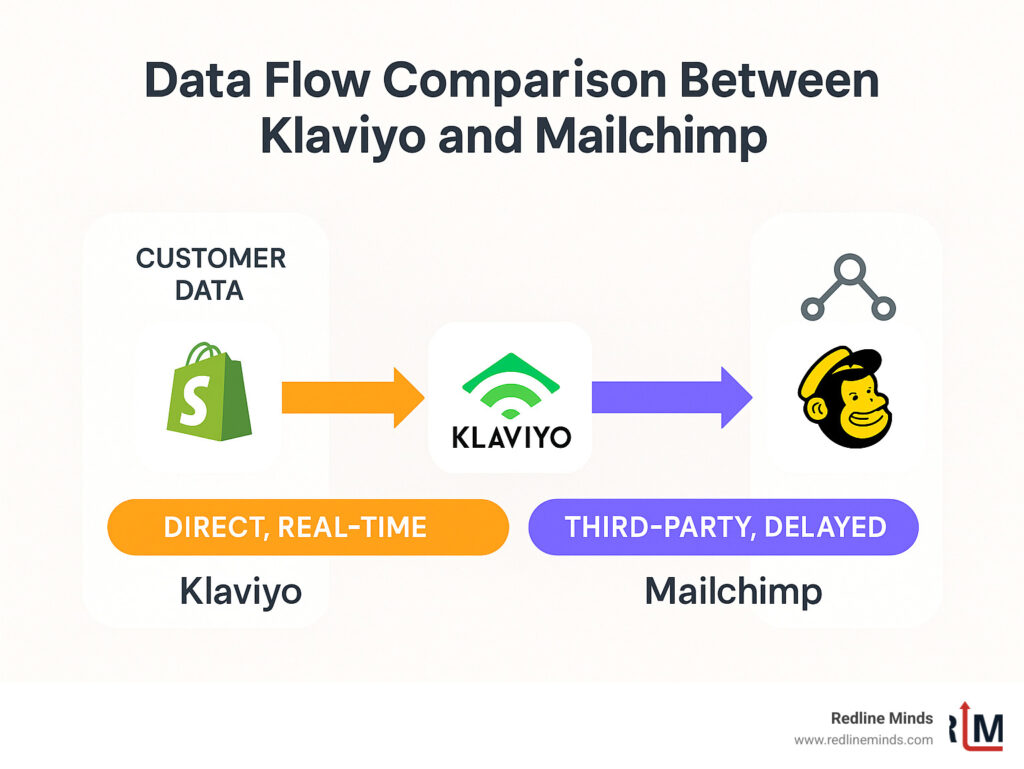
Klaviyo vs Mailchimp for Shopify: Feature Integration Faceoff
When you’re comparing Klaviyo vs. Mailchimp for Shopify, the integration quality can make or break your email marketing success. Let’s face it—your email platform needs to play nicely with your store if you want to send the right messages at the right time.
Klaviyo shines with over 300 built-in ecommerce integrations, including a seamless, native connection with Shopify. This direct integration means that when a customer abandons their cart or makes a purchase, Klaviyo knows about it instantly – no waiting, no delays.
Mailchimp, however, requires a third-party connector to work with Shopify. This extra step creates a bit of a digital traffic jam, with data taking up to 2 hours to sync between systems. By then, your abandoned cart customer might be scrolling through a competitor’s site instead!
The numbers speak for themselves on the Shopify App Store: Klaviyo maintains an impressive 4.1 rating from nearly 1,800 reviews, while Mailchimp-related connectors typically score lower because of these integration hiccups.
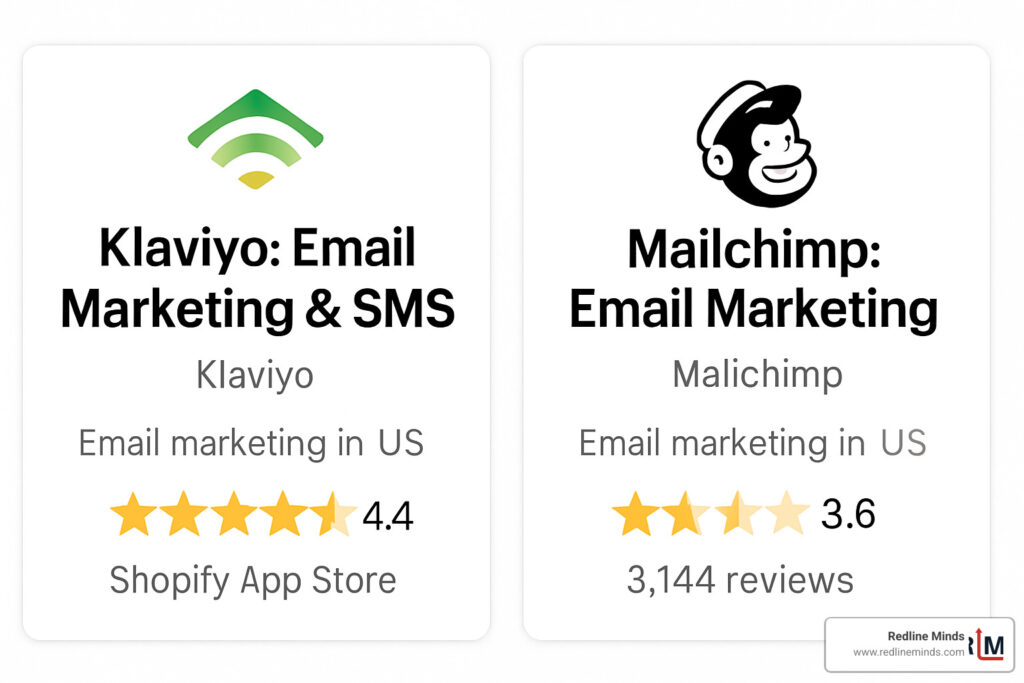
Deep-Link Integration
The way these platforms connect with Shopify affects everything about your email marketing – from data collection to campaign execution.
Klaviyo’s direct API connection captures the full picture of your customer’s journey:
- Every browsing action happens in real-time (not hours later)
- Complete checkout information, including which discount codes worked
- Up-to-the-minute product inventory status
- Detailed customer account profiles
What’s really clever is Klaviyo’s JavaScript snippet that tracks visitor behavior from their very first click, even before they’ve shared their email. Once they do subscribe, all that previous browsing history gets connected to their profile like magic.
Mailchimp’s third-party connection just can’t match this depth. While it does transfer basic purchase data, you miss out on the rich behavioral insights that power truly effective segmentation. It’s like trying to paint with only half the colors.
List Management & Contact Counting
Here’s where the Klaviyo vs Mailchimp for Shopify comparison gets really interesting for your bottom line – how they count (and charge for) contacts.
Klaviyo uses a sensible subscriber-based approach: one unique person equals one contact, no matter how many lists or segments they belong to. You pay for actual humans, not list placements.
Mailchimp counts differently, using a list-based system where the same person gets counted multiple times if they appear on different lists. This can unexpectedly inflate your costs as your marketing gets more sophisticated.
Think about it: if loyal customer Jane subscribes to your newsletter, product updates, and VIP program, Mailchimp sees three contacts while Klaviyo sees just one person named Jane.
This difference becomes a big deal as your store grows. With 10,000 actual customers, you might end up paying for 15,000-20,000 “contacts” in Mailchimp due to this overlap – money that could be better spent on growing your business!
Automation, Segmentation & Personalization Power
The magic of email marketing for Shopify stores isn’t just about sending emails—it’s about sending the right message to the right person at exactly the right moment, automatically.
When comparing Klaviyo vs Mailchimp for Shopify, the automation capabilities tell quite different stories. Klaviyo feels like it was built with your Shopify store in mind, offering over 70 pre-built automation templates (they call them “flows”) specifically designed for ecommerce. From welcoming new customers to nudging someone who abandoned their cart, Klaviyo’s templates are ready to drive sales from day one.
Mailchimp offers about 75 automation templates too, but many feel more general-purpose rather than ecommerce-focused. Their “Customer Journey Builder” works similarly to Klaviyo’s flows, but with fewer integration touchpoints and trigger options, especially on their lower-tier plans.
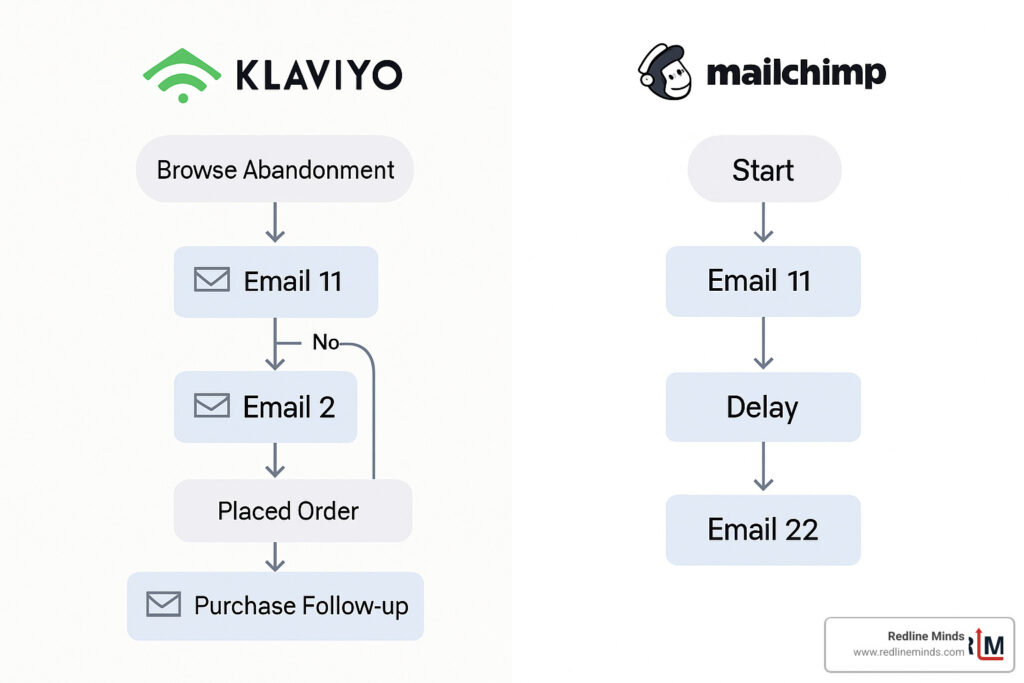
Must-Have Shopify Automations
Every successful Shopify store needs certain automated email sequences running behind the scenes. When evaluating Klaviyo vs Mailchimp for Shopify, make sure your platform can handle these revenue-generating automations effectively:
Your Welcome Series introduces new subscribers to your brand and sets the tone for your relationship. A good Abandoned Cart Recovery flow can recapture sales that were nearly lost. Browse Abandonment emails re-engage visitors who viewed products but didn’t add them to cart—something Klaviyo handles in real-time, while Mailchimp might delay by hours.
Other essential automations include Post-Purchase Follow-ups that thank customers and request reviews, Win-back Campaigns that re-engage dormant customers, Back-in-Stock Notifications, and Price Drop Alerts.
As one of our clients shared after switching platforms: “After implementing Klaviyo’s abandoned cart flow, we saw a tenfold increase in recovered revenue compared to our previous setup in Mailchimp. The timing difference was night and day.”
Want to learn more about maximizing these automations? Check out our guide to Must-Have Email Automation Flows for Ecommerce.
Real-time Segmentation Advantages
Segmentation is where the rubber really meets the road in the Klaviyo vs Mailchimp for Shopify comparison.
With Klaviyo, your segments update in real-time as customer behavior changes. Add a product to the cart? The system knows immediately. Complete a purchase? Your customer instantly moves from “potential customer” to “active customer” segments. You can create segments with unlimited conditions, use them across forms, automations, and reporting, and even leverage predictive analytics like customer lifetime value and churn risk.
Mailchimp’s approach feels more like looking in the rearview mirror—segments update every 1-2 hours, are limited to 5 conditions per segment, and rely more heavily on manual tagging. Their predictive capabilities are also more limited on lower-tier plans.
For Shopify store owners with international customers, Klaviyo’s superior segmentation allows you to manage multiple languages through a single workflow. One of our clients with a seven-language site told us: “With Klaviyo, you can use language-based segmentation to run one campaign targeting different languages, which saves us hours of duplicate work each week.”
Personalization Examples
The depth of personalization possible with each platform shows how they approach Shopify integration differently.
Klaviyo enables you to create truly personalized experiences: dynamic coupon codes unique to each recipient (preventing those coupon-sharing sites from eating into your margins), product recommendations based on actual browsing history and purchase patterns, and even coordinated messaging across email and SMS channels.
Here’s a real-world example we helped implement: A clothing retailer created a segment of customers who had previously purchased running shoes. When new running gear arrived, they sent a targeted email showcasing complementary products based on those customers’ specific preferences. The campaign achieved a 4x higher conversion rate than their standard new product announcements.
While Mailchimp offers basic personalization features, it lacks the depth of behavioral and predictive data that makes Klaviyo’s personalization feel almost magical to customers. When someone receives an email that perfectly aligns with what they were just browsing on your site, that’s the kind of relevance that converts.
Pricing, ROI & Hidden Costs
When comparing Klaviyo vs Mailchimp for Shopify, the price tag you see upfront is just the beginning of the story. Think of it like buying a car—the sticker price matters, but so do the long-term maintenance costs and how much value you’ll get from your investment.
Both platforms offer free starting points to get your email marketing off the ground:
- Klaviyo’s free plan gives you access to all email features with limitations only on contacts and how many emails you can send
- Mailchimp’s free plan takes a different approach, restricting many of the juicier features to paid tiers, which can feel a bit like they’re dangling a carrot to get you to upgrade
As your subscriber list grows (and we hope it does!), you’ll notice the pricing structures start to look quite different from each other. While we won’t quote specific numbers since they change regularly, understanding how each platform approaches billing will save you from surprise costs down the road.
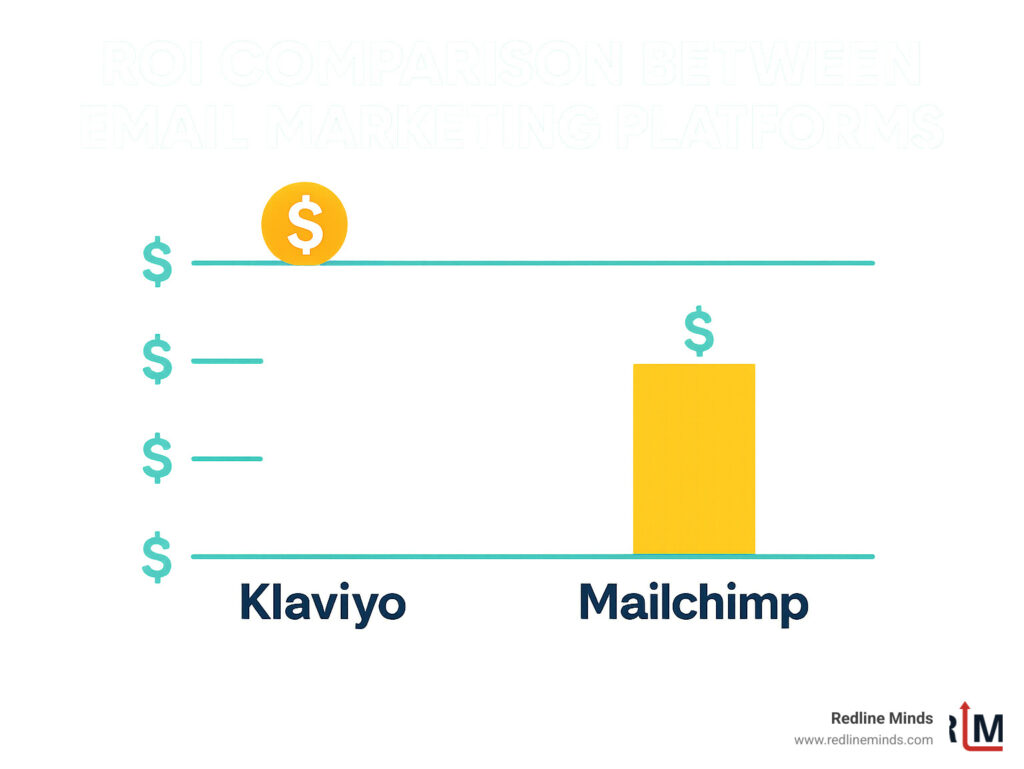
Transparent vs Layered Pricing
Klaviyo keeps things refreshingly simple with a contact-based billing model. You pay for the number of unique people in your account, regardless of how many different lists or segments they belong to. It’s like paying for actual humans rather than database entries. Plus, every feature is included at every price tier, so you’re not constantly hitting paywalls as your marketing gets more sophisticated.
Mailchimp, on the other hand, uses a list-based billing approach with tiered feature access. This means:
If Sarah subscribes to both your “New Products” and “Special Offers” lists, she counts twice in your billing. This can silently inflate your costs as your marketing gets more targeted and complex. Many store owners have been surprised when their 10,000 actual customers somehow translate to 15,000+ billable contacts!
Advanced features often require upgrading to higher-priced tiers, even if you don’t need the extra contact capacity that comes with them. And watch out for those overage fees if you exceed your plan’s limits.
For text message marketing, Klaviyo offers integrated SMS capabilities with separate credits specifically for messages. Mailchimp’s text messaging features feel more like an afterthought and often leave you needing additional services to get the job done.
As one frustrated merchant told us: “What looked like the budget-friendly option with Mailchimp ended up costing us more once we factored in the duplicate contacts across lists and all the add-ons we needed for the advanced features we wanted.”
ROI Benchmarks
When it comes to return on investment, Klaviyo truly shines for Shopify store owners—and this is where the pricing conversation gets interesting.
According to what we’ve seen from real users:
20-30% of total revenue typically comes directly from email flows and campaigns for Klaviyo users. That’s a substantial chunk of your business driven by a single marketing channel!
For every euro invested in Klaviyo, stores see approximately 85 euros returned—that’s according to Klaviyo’s own data, and it’s consistent with what we’ve observed with our clients.
Email marketing revenue often grows tenfold after switching from basic email platforms to Klaviyo’s advanced automation capabilities.
One particularly impressive case study revealed: “After implementing Klaviyo sequences, our welcome series alone generated an additional $12,000 in revenue the first month.” Those kinds of results can quickly make any price difference seem insignificant.
While Mailchimp can certainly help drive revenue through email marketing (and has for countless businesses), its limited ecommerce integration and segmentation capabilities typically result in lower conversion rates specifically for Shopify stores.
Want to learn more about maximizing your email marketing ROI? Check out our comprehensive Ecommerce Email Marketing Guide for strategies that work regardless of which platform you choose.
Analytics, Reporting & Growth Scalability
For data-driven Shopify merchants, analytics capabilities aren’t just nice-to-have features—they’re essential tools that power your marketing decisions and drive revenue growth.
When comparing Klaviyo vs Mailchimp for Shopify, the difference in reporting depth and analytical power becomes immediately apparent. These differences can significantly impact how well you understand your customers and optimize your marketing efforts.
Klaviyo’s analytics are built with ecommerce revenue in mind. Their dashboard doesn’t just show you open rates—it shows you exactly how much money your email marketing is generating as a percentage of your total store revenue. This revenue-first approach helps you see email as the profit center it should be, not just a communication channel.
Beyond the basics, Klaviyo offers cohort reports that track how different customer groups behave over time, helping you spot trends and opportunities. Their predictive analytics can forecast customer lifetime value and identify shoppers at risk of churning before they’re gone for good.
One feature that merchants particularly love is Klaviyo’s benchmarking tool, which compares your performance against similar businesses in your industry. There’s nothing like knowing exactly where you stand against your competition to motivate improvement!
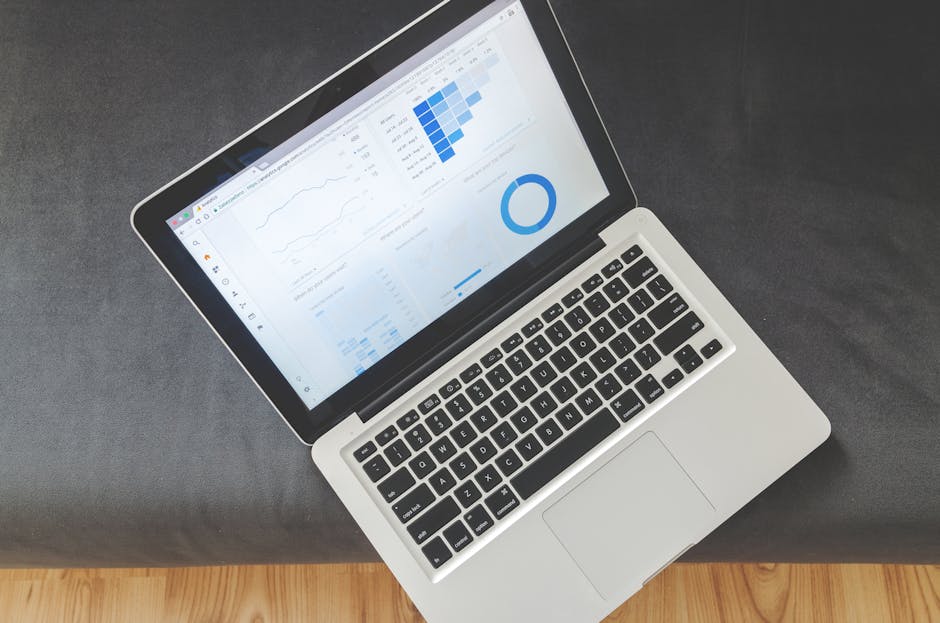
Mailchimp’s analytics, while solid for general email marketing, take a more traditional approach. You’ll get your open rates, click rates, and revenue tracking (when properly connected to Shopify), but the insights tend to be less actionable for ecommerce specifically. Their A/B testing is limited to three variants, while Klaviyo allows you to test up to seven different versions of your campaigns.
As one Shopify merchant told us: “With Klaviyo, I can see not just that a campaign performed well, but exactly which products it sold, to which customer segments, and how that compares to similar campaigns we’ve run. That level of detail makes every campaign better than the last.”
Scaling with Shopify Plus
If you’re running a Shopify Plus store or planning to scale to that level, your email marketing platform needs to grow with you. This is another area where the Klaviyo vs Mailchimp for Shopify comparison reveals important differences.
Klaviyo is built to handle enterprise-level demands with features specifically valuable to larger merchants:
High-volume sending capabilities ensure your Black Friday campaigns reach hundreds of thousands of subscribers without delivery delays. Advanced multivariate testing lets you optimize every element of your emails for maximum conversion. For the truly data-hungry, Klaviyo offers data warehouse integration for custom reporting that can merge email performance with data from other business systems.
“As we scaled past 500,000 subscribers, Klaviyo’s performance remained rock-solid,” shared one Shopify Plus merchant. “The platform grew with us, and the advanced segmentation became even more valuable at scale.”
The cross-channel coordination between email, SMS, and mobile push notifications becomes increasingly valuable as your business grows. Rather than managing multiple platforms for different channels, Klaviyo keeps all your customer communications in one place with consistent targeting and reporting.
Mailchimp can certainly accommodate growth, but many larger merchants find themselves creating workarounds or adding supplemental tools as their marketing needs become more sophisticated. The platform wasn’t originally built with enterprise ecommerce in mind, and it sometimes shows in the limitations you encounter as you scale.
For growing Shopify stores that want to make data-driven decisions, Klaviyo’s analytics provide deeper insights into how email marketing directly impacts your bottom line—and more importantly, how to continuously improve those results as you grow.
Migration, Support & Ease of Use
Switching email platforms might sound daunting, but the journey from Mailchimp to Klaviyo is surprisingly smooth for most Shopify merchants. When weighing Klaviyo vs Mailchimp for Shopify, don’t overlook the migration process, available support, and how quickly your team can adapt to the new system.
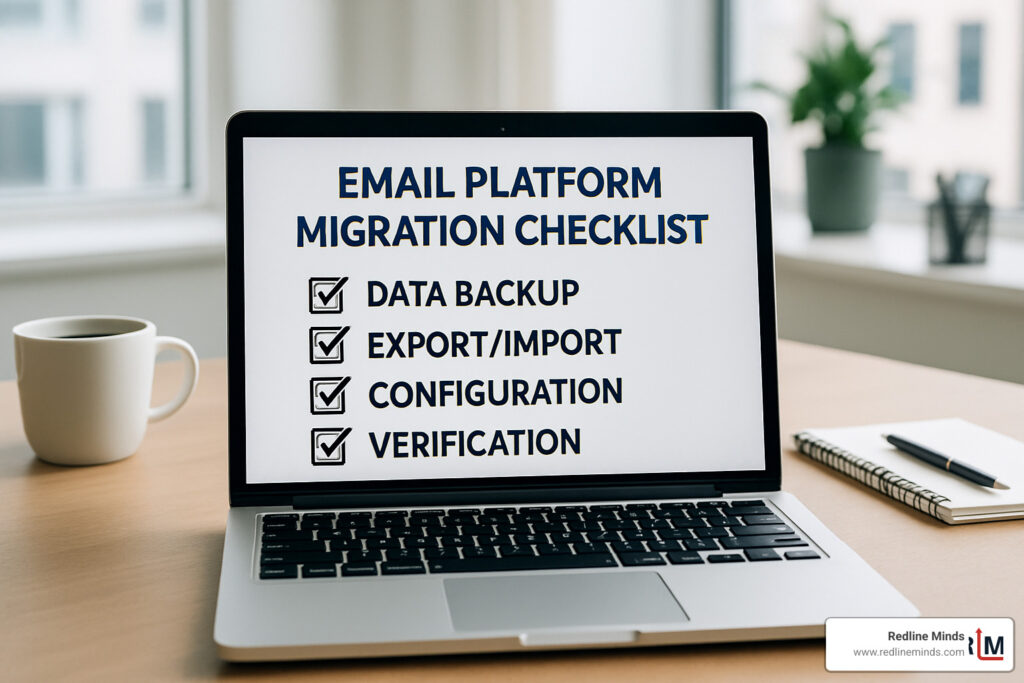
Klaviyo Migration Steps
Moving to Klaviyo is like following a well-marked trail, with their straightforward four-step process:
- Backup your Mailchimp data – Save everything from lists to campaign history (better safe than sorry!)
- Connect your Shopify store to Klaviyo – A few clicks establish that powerful direct integration
- Import your subscribers – Klaviyo’s one-time sync tool handles the heavy lifting of transferring contacts
- Set up your flows – Rebuild your automations using Klaviyo’s ready-made templates (often better than what you had before)
Most of our clients complete this transition in just a day or two. The best part? Klaviyo preserves your historical data like past purchases and customer engagement metrics during the move.
As one of our recently migrated store owners told us: “I was honestly dreading the switch, but it was much smoother than expected. Our lists transferred in a few hours, and within a week, all our automations were not just rebuilt—they were performing better than before!”
You can find detailed instructions on how to migrate from Mailchimp in 4 easy steps in Klaviyo’s help center.
Support & Learning Resources
The support experience is another area where these platforms take different approaches:
Klaviyo shines with live chat support from knowledgeable agents who understand ecommerce, not just email. Their comprehensive knowledge base and Klaviyo Academy offer certification courses that can turn your team into email marketing experts. For larger accounts, dedicated customer success managers provide personalized guidance. Most support inquiries receive responses within about 2 hours.
Mailchimp reserves its best support (chat and phone) for higher-tier plans, with everyone else relying on email support. Their knowledge base covers the basics but lacks the depth of Klaviyo’s resources. Average response times hover around 5 hours, which can feel like an eternity when you’re troubleshooting an urgent campaign.
Let’s talk learning curves. Mailchimp has earned its reputation for being beginner-friendly, as one of our clients put it: “Mailchimp is so easy even your mother could use it.” Its interface is straightforward, making it accessible for novices.
Klaviyo requires a bit more investment upfront but rewards you with significantly more power and flexibility. Their recent interface redesign has made things much more intuitive, with one of our merchants noting: “Klaviyo’s muted new design exudes a calming aura and reduces distractions while working.”
At Redline Minds, we’ve guided countless Shopify stores through this transition, providing the training and support needed for a smooth switch. Our experience shows that most teams become comfortable with Klaviyo within 2-3 weeks. After that initial learning period, they’re able to leverage advanced features that consistently drive more revenue than they ever could with Mailchimp.
Want to see what’s trending in ecommerce marketing this year? Check out our guide to Top Ecommerce Marketing Trends 2024 to stay ahead of the curve.
Frequently Asked Questions about klaviyo vs mailchimp for shopify
Is Klaviyo really more expensive once my list grows?
When you first look at pricing, Klaviyo might seem like the pricier option compared to Mailchimp. But here’s where things get interesting – the total cost often tells a completely different story.
Klaviyo counts each person only once, no matter how many lists or segments they belong to. Mailchimp, however, counts the same person multiple times if they appear on different lists. This difference can dramatically impact your monthly bill as your marketing gets more sophisticated.
I recently spoke with a boutique owner who told me: “What looked like a 30% premium for Klaviyo ended up being completely cost-neutral when we factored in all the duplicate contacts in Mailchimp. And the revenue boost more than made up for it anyway!”
Another key difference is that Klaviyo includes all features at every pricing tier, while Mailchimp locks many advanced capabilities behind higher-priced plans. Those “upsells” can add up quickly as your business grows.
When you consider the typically higher ROI that Klaviyo generates through its deeper Shopify integration, many merchants find it delivers better value despite the apparent higher price tag.
How hard is it to run multilingual campaigns?
For Shopify stores serving customers in multiple languages, email management can quickly become complex. This is another area where Klaviyo vs Mailchimp for Shopify shows meaningful differences.
Klaviyo makes multilingual campaigns surprisingly manageable with its advanced segmentation. You have two main options:
- Create separate flows for each language
- Use conditional content blocks that display different language versions based on customer preferences
One of our clients who runs a seven-language Shopify store shared: “With Klaviyo, we segment our audience by language preference and run one campaign with conditional content blocks for each language. It’s way more efficient than creating separate campaigns for each language.”
Mailchimp requires more manual work to achieve similar results. You’ll typically need separate campaigns or lists for each language, which becomes increasingly unwieldy to manage. And because of their list-based billing model, this approach can also drive up your costs considerably.
Can I keep historical data when migrating platforms?
Yes! When moving from Mailchimp to Klaviyo, you can preserve most of your valuable historical data. Klaviyo’s migration tools let you bring over:
- Subscriber profiles and all their attributes
- List memberships and segments
- Complete purchase history (when connected to Shopify)
- Campaign engagement metrics
A few things typically don’t transfer perfectly:
- Email templates (though these can be rebuilt, often with better results)
- Detailed click maps and heat maps
- Very old engagement history beyond a certain timeframe
At Redline Minds, we’ve guided dozens of merchants through this migration process. We ensure your valuable historical data stays intact while helping you rebuild and optimize your automation flows in Klaviyo. Many clients tell us they wish they’d made the switch sooner, once they see how much more effective their email marketing becomes with proper Shopify integration.
Conclusion
The Klaviyo vs Mailchimp for Shopify debate ultimately comes down to your store’s specific needs, growth trajectory, and marketing sophistication.
For small businesses just starting out with limited budgets, Mailchimp offers a friendly entry point with its intuitive interface and basic free tier. It’s the email marketing equivalent of your first apartment – it gets the job done, even if it lacks some amenities.
However, for growing Shopify merchants serious about turning email into a revenue powerhouse, Klaviyo’s ecommerce-specific features deliver dramatically better results. When merchants tell us they’re generating 20-30% of their total revenue through Klaviyo’s automated flows, they’re not exaggerating – we see these numbers consistently with our clients.
As your store grows, Klaviyo’s advantages become even more valuable:
Real-time data synchronization means your emails arrive exactly when customers are most likely to buy. When someone abandons a cart, waiting two hours to remind them (as with Mailchimp) can mean the difference between recovery and loss.
The advanced segmentation capabilities let you speak directly to specific customer needs. One of our clients increased their conversion rates by 35% simply by segmenting their audience based on past purchase categories rather than sending the same message to everyone.
Predictive analytics help you identify tomorrow’s VIPs today. Knowing which customers are likely to spend more over time lets you invest in relationships that truly matter.
At Redline Minds, we’ve guided dozens of Shopify merchants through this transition, and the results speak volumes. One client saw their email-generated revenue jump by 45% within just three months of switching from Mailchimp to Klaviyo, with abandoned cart recovery rates nearly doubling.
Remember, though – the platform is just one piece of the puzzle. Even the fanciest sports car needs a good driver. A successful email strategy requires thoughtful segmentation, compelling content, and continuous optimization regardless of which tool sits in your marketing garage.
If you’re considering making the switch or need help maximizing your current platform, our team at Redline Minds specializes in turning email marketing from a cost center into a profit generator. Based in Jefferson City, Tennessee, we work with Shopify merchants nationwide to develop email strategies that customers actually look forward to receiving.
The right choice between Klaviyo vs Mailchimp for Shopify depends on where your business stands today and where you want it to be tomorrow. For most growing Shopify stores with serious revenue ambitions, Klaviyo provides the tools, integration, and scalability needed to transform email marketing from “just another channel” into your most predictable source of revenue.